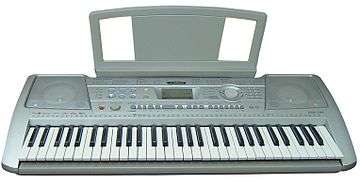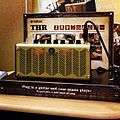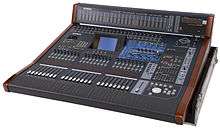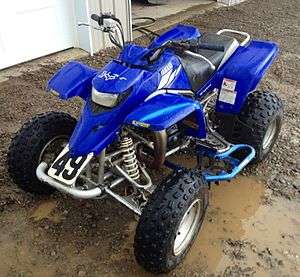Yamaha Corporation
Yamaha Corporation (ヤマハ株式会社, Yamaha Kabushiki Gaisha, /ˈjæməˌhɑː/; Japanese pronunciation: [jamaha]) is a Japanese multinational corporation and conglomerate with a very wide range of products and services. It is one of the constituents of Nikkei 225 and is the world's largest piano manufacturing company. The former motorcycle division was established in 1955 as Yamaha Motor Co., Ltd., which started as an affiliated company but later became independent, although Yamaha Corporation is still a major shareholder.
.jpg) The headquarters of Yamaha Corporation | |
Native name | ヤマハ株式会社 |
|---|---|
Romanized name | Yamaha Kabushiki-gaisha |
| Public (K.K.) | |
| Traded as | TYO: 7951 |
| ISIN | JP3942600002 |
| Founded | 12 October 1887 |
| Founder | Torakusu Yamaha |
| Headquarters | 10-1, Nakazawacho, Naka-ku, , |
Area served | Worldwide |
Key people | Takuya Nakata, President & Representative Executive Officer |
| Products | Musical instruments, audio equipment, electronics |
| Revenue | |
Number of employees | 28,112 (including temporary employees) (2017)[1] |
| Subsidiaries | |
| Website | yamaha |
History

Nippon Gakki Co. Ltd. (currently Yamaha Corporation) was established in 1887 as a piano and reed organ manufacturer by Torakusu Yamaha in Hamamatsu, Shizuoka prefecture and was incorporated on October 12, 1897. The company's origins as a musical instrument manufacturer are still reflected today in the group's logo—a trio of interlocking tuning forks.[2][3]
After World War II, company president Genichi Kawakami repurposed the remains of the company's war-time production machinery and the company's expertise in metallurgical technologies to the manufacture of motorcycles. The YA-1 (AKA Akatombo, the "Red Dragonfly"), of which 125 were built in the first year of production (1954), was named in honour of the founder. It was a 125cc, single cylinder, two-stroke, street bike patterned after the German DKW RT125 (which the British munitions firm, BSA, had also copied in the post-war era and manufactured as the Bantam and Harley-Davidson as the Hummer). In 1955,[4] the success of the YA-1 resulted in the founding of Yamaha Motor Co., Ltd., splitting the motorcycle division from the company.
Also, in 1954 the Yamaha Music School was founded.[3]

Yamaha has grown to become the world's largest manufacturer of musical instruments (including pianos, "silent" pianos, drums, guitars, brass instruments, woodwinds, violins, violas, celli, and vibraphones), as well as a leading manufacturer of semiconductors, audio/visual, computer related products, sporting goods, home appliances, specialty metals and industrial robots.[5] Yamaha released the Yamaha CS-80 in 1977.
Yamaha made the first commercially successful digital synthesizer, the Yamaha DX7, in 1983.
In 1988, Yamaha shipped the world's first CD recorder.[6] Yamaha purchased Sequential Circuits in 1988.[7] It bought a majority stake (51%) of competitor Korg in 1987, which was bought out by Korg in 1993.[8]
In the late 1990s, Yamaha released a series of portable battery operated keyboards under the PSS and the PSR range of keyboards. The Yamaha PSS-14 and PSS-15 keyboards were upgrades to the Yamaha PSS-7 and were notable for their short demo songs, short selectable phrases, funny sound effects and distortion and crackly sounds progressing on many volume levels when battery power is low.[9]
In 2002, Yamaha closed down its archery product business that was started in 1959. Six archers in five different Olympic Games won gold medals using their products.[10]
In January 2005, it acquired German audio software manufacturer Steinberg from Pinnacle Systems.
In July, 2007, Yamaha bought out the minority shareholding of the Kemble family in Yamaha-Kemble Music (UK) Ltd, Yamaha's UK import and musical instrument and professional audio equipment sales arm, the company being renamed Yamaha Music U.K. Ltd in autumn 2007.[11] Kemble & Co. Ltd, the UK piano sales & manufacturing arm was unaffected.[12]
On December 20, 2007, Yamaha made an agreement with the Austrian Bank BAWAG P.S.K. Group BAWAG to purchase all the shares of Bösendorfer,[13] intended to take place in early 2008. Yamaha intends to continue manufacturing at the Bösendorfer facilities in Austria.[14] The acquisition of Bösendorfer was announced after the NAMM Show in Los Angeles, on January 28, 2008. As of February 1, 2008, Bösendorfer Klavierfabrik GmbH operates as a subsidiary of Yamaha Corp.[15]
Yamaha Corporation is also widely known for their music teaching programme that began in the 1950s.
Yamaha electronics have proven to be successful, popular and respected products. For example, the Yamaha YPG-625 was awarded "Keyboard of the Year" and "Product of the Year" in 2007 from The Music and Sound Retailer magazine.[16] Other noteworthy Yamaha electronics include the SHS-10 Keytar, a consumer-priced keytar which offered MIDI output features normally found on much more expensive keyboards.
Other companies in the Yamaha Corporation group include:
- Bösendorfer Klavierfabrik GmbH, Vienna, Austria.
- Yamaha Fine Technologies Co., Ltd.
- Yamaha Music Communications Co., Ltd.
- Yamaha Pro Audio
Corporate mission
Kandō (感動) is a Japanese word used by Yamaha Corporation to describe their corporate mission. Kandō in translation describes the sensation of profound excitement and gratification derived from experiencing supreme quality and performance.[17] Some reasonable English synonyms are "emotionally touching" or "emotionally moving".
Yamaha Music Foundation
The Yamaha Music Foundation is an organization established in 1966 by the authority of the Japanese Ministry of Education for the purpose of promoting music education and music popularization. It continued a program of music classes begun by Yamaha Corporation in 1954.[18]
Products
Yamaha expanded into many diverse businesses and product groups. The first venture into each major category is listed below.[19]
- 1897 Keyboard instruments (reed organ, pianos in 1900)
- 1903 Furniture
- 1914 Harmonicas
- 1922 Audio equipment (crank phonograph first)
- 1942 Guitars
- 1955 Motorcycles – made by Yamaha Motor Company, which started as an affiliated company of Nippon Gakki (Yamaha Corporation's name at the time) but is a separate company today; therefore, products of Yamaha Corporation formerly also included motorcycles
- 1959 Sporting goods (starting with archery)
- 1959 Music schools
- 1961 Metal alloys
- 1965 Band instruments (trumpet first)
- 1967 Drums
- 1971 Semiconductors
- 2001 Yamaha Entertainment Group (record company)
.jpg) Yamaha Grand Piano
Yamaha Grand Piano Yamaha Keyboard
Yamaha Keyboard Yamaha Drumset
Yamaha Drumset Yamaha Saxophone
Yamaha Saxophone Yamaha Guitars
Yamaha Guitars Yamaha Acoustic Guitar Amp
Yamaha Acoustic Guitar Amp Yamaha Mixing Console
Yamaha Mixing Console.jpg) Yamaha Hi-Fi
Yamaha Hi-Fi Yamaha Sound Chip
Yamaha Sound Chip Yamaha AV Receiver
Yamaha AV Receiver- Yamaha Speakers
- Yamaha DVD Player

.jpg) Yamaha Waverunner
Yamaha Waverunner Yamaha Snowmobile
Yamaha Snowmobile
.jpg) Yamaha Golf Cart
Yamaha Golf Cart- Yamaha Outboard Motor
Synthesizers and samplers
Yamaha announced the singing synthesizer Vocaloid for the first time at the German fair Musikmesse on March 5–9, 2003.[20]
Yamaha also began to get involved with the sale and production of Vocaloid applications themselves with Lily being the first; Lily was later sold via Internet Co., Ltd.'s website. Their involvement continued with the VY series, with VY1 being the first, released in deluxe and standard editions on September 1, 2010.[21] The VY series is a series designed to be a high quality product for professional musicians. The series is also designed with the intention to set a new standard for the Vocaloids for having no face, sex or set voice, but are designed to complete any song.[22] VY1 saw a new approach to how the software handled the database of samples and improved the performance of the Vocaloid 2 engine.
Yamaha announced a version of the Vocaloid 2 software for the iPhone and iPad, which exhibited at the Y2 Autumn 2010 Digital Content Expo in Japan.[23][24] Later, this version of the software was released using the VY1 voice.[25][26] VY2 will also be released for this version of the software.[27]
Factory locations
In Japan, the company maintains three factories for musical instrument manufacture, engine and various vehicle manufacture (motorcycles and marine products), with all factories located in Shizuoka Prefecture.
- Kakegawa Factory
- 1480, Ryoke, Kakegawa-shi, Shizuoka
- Toyooka Factory
- 203, Matsunokijima, Iwata-shi, Shizuoka
- Tenryu Factory
- 283, Aoyacho, Minami-ku Hamamatsu-shi, Shizuoka
Sports teams
- Yamaha Jubilo—Rugby
- Júbilo Iwata—Football
See also
References
- Annual Report 2017
- "Yamaha Corporate Information". Global website. Yamaha Corporation.
- "Brand and History - About Us - Yamaha Corporation". www.yamaha.com. Retrieved 2018-07-01.
- "Yamaha Motor". Forbes Global 2000 List.
- "Yamaha Corporate History". Yamaha Corporation of America & Yamaha Corporation. Retrieved 2011-04-26.
- Verna, Paul (1999-04-03). "CD-R Enjoys Massive Growth In A Wide Range Of Markets". Billboard. Retrieved 21 March 2018.
-
Gordon Reid (March 1999). "PROPHET LINE — Sequential Circuits: Prophet Synthesizers 5 & 10 (Retro)". Sound On Sound. Archived from the original on 2004-03-29.
1989-1999 In 1988, Yamaha bought the rights and assets of SCI, and these rights included the employment contracts of many of the company's development team, including Dave Smith himself. … Then, in 1989, the team moved to Korg, where they designed the now-classic Wavestations. …
-
Gordon Reid (November 2002). "40 Years Of Gear — The History Of Korg: Part 2". Sound On Sound. Archived from the original on 2003-11-19.
1987 … However, in 1987, the relationship took another huge step forward when Yamaha bought a controlling interest in Korg Inc, effectively making it a subsidiary."; "1993 … Thanks to the products developed using the funds from Yamaha's cash injection in 1987, the previous five years had been very successful, and Tsutomu Katoh now had some cash at his disposal. In fact, he had enough to buy out the majority of Yamaha's share in Korg. So he did.
- "PSS-14 Portable Keyboard". Yamaha. Missing or empty
|url=(help) - "YAMAHA to Close Archery Products Business". Yamaha Corporation. 2002-02-01. Archived from the original on 2004-01-16. Retrieved 2008-04-30.
- "Cancellation of Joint Venture Contracts for Sales Subsidiaries in U.K. and Spain". Yamaha Global website. July 10, 2007.
- Barrett, Andy (July 10, 2007). "Yamaha buys out Kemble family". MI Pro.
- "Competition For Bosendorfer". Forbes. 2007-11-30.
- "Yamaha Reaches Basic Agreement with Austrian Bank to Purchase All Shares of Bösendorfer". Yamaha Global website. December 20, 2007.
- "Bosendorfer Klavierfabrik GmbH". Business Week. March 3, 2008.
- "YPG-625 - 88-key Weighted Action Portable Grand". Yamha Corporation of America & Yamaha Corporation.
- "Yamaha Corporate Mission". Yamaha Motor UK.
- "Yamaha Music Foundation History". Yamaha Music Foundation.
- "Yamaha History". Corporate Information, Global website. Yamaha Corporation. Retrieved 2012-11-13.
- "New Yamaha VOCALOID Singing Synthesis Software Generates Superb Vocals on a PC". Business Wire. AllBusiness.com. March 4, 2003. Retrieved October 25, 2010.
- "新型ボーカロイド「VY1」公開です!" [New Model Vocaloid "VY1" Presentation!] (in Japanese). Bplats. August 13, 2010. Archived from the original on July 17, 2011. Retrieved August 13, 2010.
- Okada, Yuka (August 13, 2010). "キャラクターなしのVOCALOID「VY1」 初のヤマハ製、9月発売" ["VY1", a Vocaloid With No Character, First Yamaha-Made, Sold in September] (in Japanese). IT Media. Retrieved September 5, 2010.
- "デジタルコンテンツEXPO:VOCALOIDがiPad/iPhoneアプリに ヤマハが開発" [Digital Content Expo: Vocaloid Becomes iPad/iPhone Applications. Yamaha Develops Those] (in Japanese). IT Media. October 14, 2010. Retrieved October 17, 2010.
- "Y2 Autumn 2010 | Digital Content Expo 2010" (in Japanese). Digital Content Expo. Archived from the original on 2010-10-07. Retrieved October 17, 2010.
- "iVOCALOID-VY1" (in Japanese). Apple Inc. Retrieved December 13, 2010.
- "iVOCALOID-VY1t" (in Japanese). Apple Inc. Retrieved December 13, 2010.
- Matsuo, Kōya (April 15, 2011). "コードネームは「勇馬」 ヤマハ純正のイケメンボカロ「VY2」の話を聞いてきた" [Codename Is "Yūma". I Heard the Story of the Yamaha Pure Cool Vocalo "VY2"] (in Japanese). IT Media. Retrieved April 28, 2011.
External links
| Wikimedia Commons has media related to Yamaha clarinets. |
- Official website
- Takuya Nakata Interview NAMM Oral History Library (2009)
- Hitoshi Fukutome Interview NAMM Oral History Library (2013)
- Hiroo Okabe Interview NAMM Oral History Library
- Tetsuya Takagi Interview NAMM Oral History Library (2005)
- Mitsuru Umemura Interview NAMM Oral History Interview (2009)